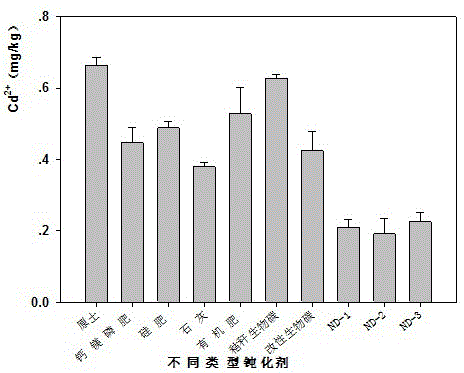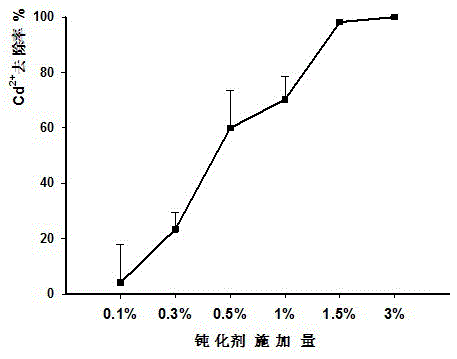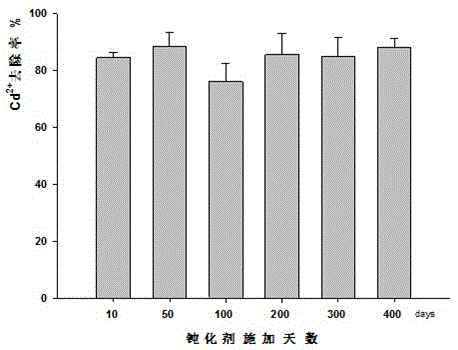Passivating agent for weakly acidic cadmium contaminated soil and application thereof
A technology of cadmium-contaminated soil and passivating agent, which is applied in the restoration, application, soil conditioning materials and other directions of polluted soil, can solve the problem of increasing cadmium content, difficult to guarantee the long-term effectiveness of passivating agent, and invariable change of extractable cadmium content. Obvious and other problems to achieve the effect of improving stability and satisfying efficient and fast repair
- Summary
- Abstract
- Description
- Claims
- Application Information
AI Technical Summary
Problems solved by technology
Method used
Image
Examples
Embodiment 1
[0040] Embodiment 1 prepares passivator ND-1
[0041] (1) Take 100g of straw biochar prepared at 300°C, grind and crush it, and pass it through an 80-mesh nylon sieve;
[0042] (2) Soak the biochar in a mixed solution with a final concentration of 1mol / L sodium sulfide and 10% sulfuric acid for 3 hours, and the mass ratio of biochar to the mixed solution is 1:3;
[0043](3) Place the soaked mixed system in an ultrasonic cleaner for 20 minutes of ultrasonic reaction with an ultrasonic power of 400W; then place the reaction system in a microwave chemical reactor for 10 minutes of microwave reaction with a microwave power of 600W;
[0044] (4) Separate the biochar from the mixed solution through suction filtration of the mixed system obtained by the above microwave reaction, wash the biochar with deionized water until it is neutral, and dry it in an oven at 70°C to obtain modified carbon;
[0045] (5) Compound the purchased calcium oxide, fly ash, calcium magnesium phosphate fer...
Embodiment 2
[0047] Embodiment 2 prepares passivator ND-2
[0048] (1) Take 100g of straw biochar prepared at a temperature of 400°C, grind and crush it, and pass it through a 100-mesh nylon sieve:
[0049] (2) Soak the biochar in a mixed solution of 1mol / L sodium sulfide and 10% sulfuric acid for 4 hours, and the mass ratio of biochar to the mixed solution is 1:4;
[0050] (3) Place the soaked mixed system in an ultrasonic cleaning machine for 25 minutes of ultrasonic reaction with an ultrasonic power of 600W; then place the reaction system in a microwave chemical reactor for 15 minutes of microwave reaction with a microwave power of 800W;
[0051] (4) Separate the biochar from the mixed solution through suction filtration of the mixed system after the microwave reaction, wash the biochar with deionized water until it is neutral, and dry it in an oven at 70°C to obtain modified biochar;
[0052] (5) Compound the purchased calcium oxide, fly ash, calcium magnesium phosphate fertilizer, an...
Embodiment 3
[0054] Embodiment 3 prepares passivator ND-3
[0055] (1) Take 100g of straw biochar prepared at a temperature of about 500°C, grind and crush it, and pass it through a 100-mesh nylon sieve;
[0056] (2) Soak the biochar in a mixed solution of 1mol / L sodium sulfide and 10% sulfuric acid for 5 hours, and the mass ratio of biochar to the mixed solution is 1:5;
[0057] (3) Put the above mixed system in an ultrasonic cleaning machine, ultrasonically react for 30min, and the ultrasonic power is 800W; then place the reaction system in a microwave chemical reactor for microwave reaction for 20min, with a microwave power of 1000W;
[0058] (4) Separate the biochar from the mixed solution through suction filtration of the mixed system after the microwave reaction, wash the biochar with deionized water until it is neutral, and dry it in an oven at 70°C to obtain modified biochar;
[0059] (5) Compound the purchased calcium oxide, fly ash, calcium magnesium phosphate fertilizer, and so...
PUM
 Login to View More
Login to View More Abstract
Description
Claims
Application Information
 Login to View More
Login to View More - Generate Ideas
- Intellectual Property
- Life Sciences
- Materials
- Tech Scout
- Unparalleled Data Quality
- Higher Quality Content
- 60% Fewer Hallucinations
Browse by: Latest US Patents, China's latest patents, Technical Efficacy Thesaurus, Application Domain, Technology Topic, Popular Technical Reports.
© 2025 PatSnap. All rights reserved.Legal|Privacy policy|Modern Slavery Act Transparency Statement|Sitemap|About US| Contact US: help@patsnap.com



